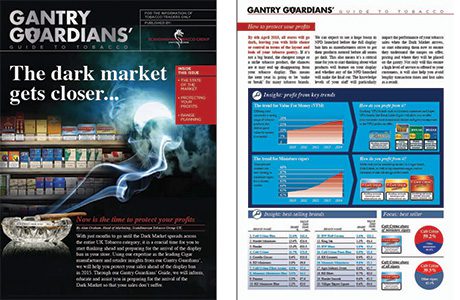
• Scotland’s tobacco display ban will take effect officially in small stores in Scotland on 6 April, 2015. But many shops now have their covered gantries in place and are using the remaining weeks to ensure staff and customers are prepared for the new regime.
• How are tobacco companies responding and what should retailers do to minimise commercial difficulties?
IN two months the tobacco display ban will be enacted in small stores in Scotland. When c-stores and CTNs join the supermarkets in covering tobacco and related products it will mean that, in just about every case, cigarettes, RYO tobacco, cigars and other products will only be allowed to be revealed in strictly regulated ways when a transaction with an adult smoker is taking place or when tobacco gantries are being restocked.
The programme to install new compliant equipment – mostly supplied by the tobacco industry’s big two of Imperial Tobacco and JTI – is already under way and many shops in Scotland have already completely or partially covered their tobacco displays. It would be impossible to change all displays on a single day and covering up early gives retailers the chance to train staff and ease both employees and consumers into the new system.
In particular, retailers can label the flaps – which most of the north-of-the-border systems use to meet the particularly stringent Scottish rules – to help staff memorise where key tobacco SKU’s are placed behind the screens. At present there’s no restriction on size of lettering but fonts and typesizes will be strictly regulated after the enactment of the ban on 6 April.
Not all small shops have been offered compliant gantries from the tobacco firms, but very many have. The companies retain ownership of the equipment and will often require store operators to use specific layouts of brands and pack sizes behind the screens, just as they sought retailers to work to planograms in the days when open display was allowed.
There are also third-party solutions which aren’t free but do provide facilities for stores outside the gantry programmes of suppliers or who simply want to do their own thing.
• Tobacco firm JTI committed to covering up more than 13,500 independent-store gantries and began the work in October last year.
“The size of this project is huge,” said Jeremy Blackburn, JTI’s head of communications.
Stores over 3,000 sq ft, including multiple grocers’ outlets and independent small supermarkets had to make the transition to operating in a display ban environment in Scotland in 2013, and insights are available.
JTI-gantry customer Terry Feeney oversaw the introduction of the restricted market doors at his Nisa Extra store in Linwood. He said: “Prepare early and ensure staff are fully trained. This is the advice I followed and my sales weren’t affected. The fact that my staff had the opportunity to familiarise themselves with the ‘dark’ planogram before the flaps were fitted also meant that I didn’t lose custom to neighbouring larger stores through increased queue times. Tobacco sales continue to make up 25% of my business.
“Stocking a mix of price-marked and non-price-marked packs helped me achieve this and, to this day, continues to drive repeat custom.”
Blackburn said: “JTI will continue to maintain the current level of face-to-face service across Scotland. JTI will also maintain the development of its key UK brand portfolio.
“It is vital to maintain a strong range and portfolio of tobacco brands and retailers should not see the display ban as an opportunity to de-stock and delist tobacco lines.”
The firm has for some time summed up its advice on merchandising with a list of headings it calls ARTIST, which stands for availability, range, training, innovation, sales and technology. In a restricted market the points become even more important, Blackburn suggested. And the firm says retailers should redouble efforts to: ensure 100% availability by regularly checking stocks and refilling as required; offer a wide range of cigarettes, RYO and cigars across different pack sizes; ensure staff are well-trained and up to date with all
legislation; support new products and packs; understand sales trends in the market; and use data and other technological tools to stay on top of key sales and stock information.
On training, JTI emphasises the need for retailers and their staff to be fully aware of important changes that occur as a result of the ban.
“In Scotland, the fines are up to £2,500 if prosecuted. However, the local authority could give a fixed penalty on-the-spot fine of £200 – £150 if paid within 14 days,” Blackburn said.
“The fixed penalty will increase in value for each subsequent breach and retailers could be banned from selling tobacco products if they or their staff commit three or more offences.”
Currently if someone sells tobacco to anyone under the age of 18 an offence is committed once the sale is completed. After the ban it will be illegal to open the gantry to anyone under the age of 18.
“No ID, No Sale!” till prompts will become obsolete, Blackburn stressed. Retailers must remember to challenge for ID before opening the gantry.

• At Imperial Tobacco, Andrew Miller, the company’s head of independent retail said: “We are currently working on a delivery schedule which will ensure retailers are compliant long before the 6 April, 2015 deadline.
“With these installations we will also be providing staff training on aspects, amongst others, such as security and maintenance of the doors.
“For our Scottish retailers who no longer receive a physical visit from an Imperial Tobacco rep our Customer Service Centre, which was set up 18 months ago, is continuing to offer support and advice on the dark market.”
Stuart Mead, customer relationship centre manager at Imperial Tobacco said: “Scottish retailers need to place an increased focus on analysing market data. Identifying sales patterns will help to avoid out of stocks when display restrictions are enforced. One thing we learnt from our experiences in Australia is that availability drops in a dark market. Getting into the habit of carrying out regular availability checks and marking key lines off on a checklist now will make the transition far smoother.
“Retailers should also consider placing reminder cards on autofeeds so that staff are aware of what product goes in each space.
“And keep a customer request book for new products so they don’t get forgotten on the next order.
“We are distributing dark market information packs which contain key information about the forthcoming display regulations. The guide can be downloaded under the Useful Downloads area of the www.imperial-trade.com trade website.”

• Marlboro and Chesterfield supplier Philip Morris last Autumn told Scottish Grocer that while it would not be supplying gantries its recently established field force will regularly visit retailers to advise them on how to make the most of their displays and ranges before and after the ban.
Recently, Jerry Margolis, the firm’s sales director for the UK and the Republic of Ireland said stores in Scotland have to decide the best way to service adult smokers and maintain an efficient operation.
“This involves making the important decision on whether some of the best real estate in the store is better served for other high-profit items, keeping your tobacco range in a closed unit below or above the counter rather than investing in doors or shutters to hide your tobacco range.
“2014 will definitely go down as an extraordinary year in Philip Morris’s UK’s history. Not only have our brands delivered impressive growth – we are up 0.6 percentage points on last year to 7.9% share of market – but we have grown as an organisation too.
“For the first time in 25 years we have a dedicated national field force and we are thrilled to have a team on the street focused on our portfolio and assisting retailers every day.”
• Late last year the cigars and RYO specialist Scandinavian Tobacco Group UK released the second edition of its Gantry Guardians Guide to Tobacco in a bid to help independent retailers prepare for the display ban. The guide highlights key actions retailers need to take before the market goes dark. The guide also includes advice from STG UK’s Gantry Guardians, established successful retailers who have contributed opinions and news of their own experiences as part of guide.
• At specialist tobacco supplier Santa Fe Natural Tobacco Company UK, which provides the Natural American Spirit range of cigarettes and RYO tobacco, general manager Alan Graham said representatives will be visiting many independent stores and will be happy to offer advice on ranging and merchandising in the lead up to the display ban and beyond.
“Scottish stores do have a bigger burden to carry with the smaller size of opening allowed at only 1000 sq cm,” he said.
Evidence from large stores, who have two years experience of the display ban in Scotland and three years south of the border, shows some clear trends, he suggested.
“Three key areas within tobacco tend to win – the largest brands in each sub-category, the cheapest, and truly niche products.
“Natural American Spirit is indeed truly niche as the UK’s largest additive-free tobacco brand and will continue to be asked for by consumers,” he argued.
“Stock the three key areas – large brands, the cheapest and truly niche products. Keep fully stocked, consumers will buy elsewhere if disappointed. Ensure that your staff know the gantry well, especially where each brand is, and the pricing, and that they have good product knowledge.”


















